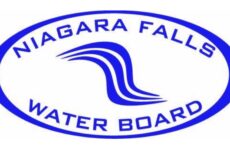By Jim Hufnagel

The passenger windows on the Discover Niagara shuttle were recently heavily tinted so that the empty seats wouldn’t be so embarrassingly evident.
Recently the Niagara Falls National Heritage Area reported that its new Discover Niagara shuttle, which functions to remove tourists from downtown Niagara Falls to attractions in Lewiston and Youngstown, including their Center Street and Main Street business districts, respectively, boarded its 10,000th rider over the weekend of July 9-10.
The shuttle is funded by NYPA, Niagara Falls State Park, the NTCC, USA Niagara, Niagara Falls National Heritage and Assemblyman Ceretto’s office to the tune of $820,000 a year for two years.
Uncharacteristically, since they usually throw money at anything that moves and, considering the soon-to-be-unveiled $585,000 Boundary Waters sculpture, much that does not, it appears that Mayor Dyster and his council majority for some reason passed on the opportunity to subsidize the ferrying of tourists out of downtown Niagara Falls.
We decided to do a little 4th grade math in an attempt to determine the cost effectiveness of the new shuttle service.
Running approximately every 35 minutes from 9 a.m. to 7 p.m. daily, that’s 18 circuits a day, and having commenced on May 26, as of July 3 the Discover Niagara shuttle had made some 702 round trips accommodating, according to National Heritage, 7,664 riders. A week later it was claimed the number of riders was projected to surpass 10,000.
We’re going to work with the 7,664 figure since that was an actual count given for a specific date.
7,664 passengers divided by 702 trips works out to slightly less than 11 passengers getting on the shuttle at some point during every 14 mile trip from downtown Niagara Falls to Fort Niagara and back again.
Therefore, a typical trip could look like the following: two riders board at “the Turtle”, two in front of the NTCC, two at Old Falls Street, and let’s say, four of those six get off at the Aquarium or Whirlpool State Park. Our sample shuttle would conceivably make the trip to Lewiston with two lone passengers. Picking up six more at the Castellani, Power Vista, Lewiston and Youngstown strips or Fort Niagara and bringing them back to downtown Niagara Falls, completing the circuit with just this sparse handful of tourists, would more than exceed the observed 11-passenger ridership per trip, which amounts to substantially less than one boarding passenger for each of 14 stops.
And if passengers disembark at attractions like the Castellani, Power Vista or Fort Niagara, and re-board one or more times later (which, after all, is the purpose of the whole enterprise, to drop tourists off at one or more locations and pick them up afterwards), does that mean they’re counted more than once? Could the 7,664 reported total actually comprise 3832 who got on and off once during the trip? Are people who get on and off the shuttle repeatedly on their Discover Niagara shuttle excursion counted multiple times?

At a more than $28 subsidy per passenger, these Redcoats are in no hurry to “Brexit” the Discovery shuttle!
Most who have been in the position of justifying funding from granting agencies to support some project have an appreciation for the strategic fudging of numbers. “We want to make a really strong case for this to continue for years to come,” revealed National Heritage director Sara Capen in a recent Gazette write-up on the shuttle, “(the ridership statistics) providing a model that we can continue to cultivate.”
The May 26 through October 19 scheduled run for the shuttle amounts to 147 days of operation.
Extrapolating from the official tally of 7,664 on July 3, total 2016 ridership is projected to be 28,887.
As previously stated, the shuttle’s annual budget is $820,000.
Therefore, the cost per passenger is $28.39, and that doesn’t take into consideration that tourist attendance drops off precipitously after Labor Day, which would produce an even higher result.
It may be the taxpayers (courtesy of State Parks, Ceretto’s office and USA Niagara), ratepayers (courtesy of NYPA) and hotels that pay bed tax (courtesy of NTCC), that are on the hook for bankrolling this experiment for two years, and possibly beyond, would be better off simply paying people $28 at the door to visit their attractions. Or offering a mail-in rebate of some kind.
The Discover Niagara shuttle initiative so far appears entirely consistent with all the other so-called economic development programs inflicted on Niagara Falls over the years by the politicians, state agencies and professional tourism bureaucrats, ensuring that the maximum amount of public money is spent to minimal impact.




















